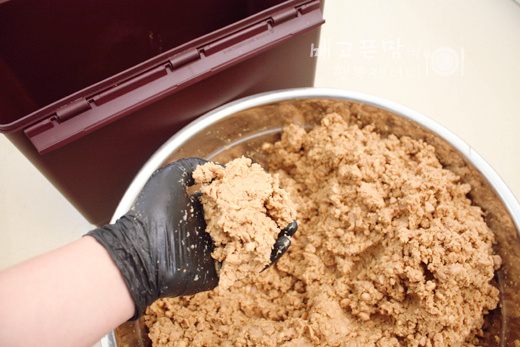Golden Homemade Soy Sauce & Doenjang Making: The 90-Day Fermentation Secret
How to Make Savory Doenjang and Flavorful Soy Sauce: A Complete Guide Using a Fermentation Kit

After a 90-day wait, your homemade doenjang and soy sauce are ready! This guide provides detailed instructions on how to easily make delicious fermented pastes at home using an internet-ordered fermentation kit. Take on the seemingly complex task of making traditional Korean pastes with confidence!
Key Ingredients- 5kg Dried Soybean Meju Beans
- 1kg High-Quality Meju Powder
- 9.2kg Premium Sea Salt
- 20L Purified Water
Cooking Instructions
Step 1
For the first 90 days after making the paste, I did not open the lid even once. The instructions for the fermentation kit I purchased stated that minimizing air exposure leads to cleaner and tastier pastes, so I kept both the inner and outer lids tightly sealed for the entire 90-day period.

Step 2
After 90 days, when I opened the lid with anticipation, I was greeted by a lovely layer of white mold. This is a positive sign that the paste is fermenting well!

Step 3
Now it’s time to separate the soy sauce. Using a fine-mesh skimmer, carefully remove as much of the white mold as possible from the surface. It’s crucial that any tools used for separating the soy sauce are completely dry and free of water. This skimmer should not be washed with water; after scooping out the mold, I wiped the mesh clean with paper towels between uses.

Step 4
Thoroughly skim off the mold to prepare for clear and clean soy sauce extraction.

Step 5
Prepare a large bowl for the meju. Now, it’s time to carefully remove the bag containing the meju beans. Gently take out the bag.

Step 6
If the container opening is narrow, you can slightly open the bag’s mouth and scoop out about half of the meju beans into the bowl with your hands before carefully removing the bag. This makes the process easier.

Step 7
After removing the meju, the soy sauce needs to be transferred to bottles. At home, I only had a small 500ml pitcher, which made the process a bit challenging, but I resolved to buy a larger tool next time. Although the pitcher has a fine mesh, I added an extra layer of clean cotton cloth as a precaution to filter the soy sauce.

Step 8
Next, carefully ladle the soy sauce into the pitcher and then into the bottles.

Step 9
I saved and rinsed the water bottles that were used when making the paste. This purified water will be used to dilute the soy sauce. Pour the soy sauce into a 2-liter water bottle. I strained it once more through the cotton cloth to remove any remaining solids, ensuring only clear soy sauce goes into the bottle.

Step 10
This yielded 8 bottles of 2-liter soy sauce, with an additional 200-300ml. Considering some spillage during the meju removal and pouring process, this is a considerable amount of soy sauce.

Step 11
As I proceeded, the meju particles started to clog the cotton cloth more as the soy sauce level decreased towards the bottom. It became difficult to filter through the cloth, so I removed it and used only the pitcher’s mesh. This step was a bit tedious and time-consuming but necessary for clear soy sauce.

Step 12
Now, it’s time to make the doenjang. Prepare 1 kg of meju powder, which was included in the fermentation kit.

Step 13
Following the product instructions, add all the meju powder to the remaining doenjang mass after removing the meju.

Step 14
Wearing rubber gloves, knead the meju powder and doenjang together thoroughly with your hands until evenly mixed and smooth, like kneading dough.

Step 15
Pour the remaining soy sauce from the bottles into the doenjang. This soy sauce will add depth of flavor to the doenjang.

Step 16
If the doenjang is too stiff, adding the remaining soy sauce and kneading well will make it moist and create a smoother consistency. Adjusting the thickness is important.

Step 17
Transfer the well-mixed and softened doenjang into a clean kimchi container.

Step 18
Press the doenjang down firmly into the container, ensuring there are no air pockets. Smooth the surface evenly.

Step 19
Cover the surface of the doenjang with plastic wrap to create a seal. Minimizing air exposure is key to long-term storage and developing a delicious doenjang.

Step 20
Now, all that’s left is to let the finished soy sauce and doenjang mature for another 2-3 months at room temperature (20-23°C). With time, they will develop an even deeper and richer flavor!



